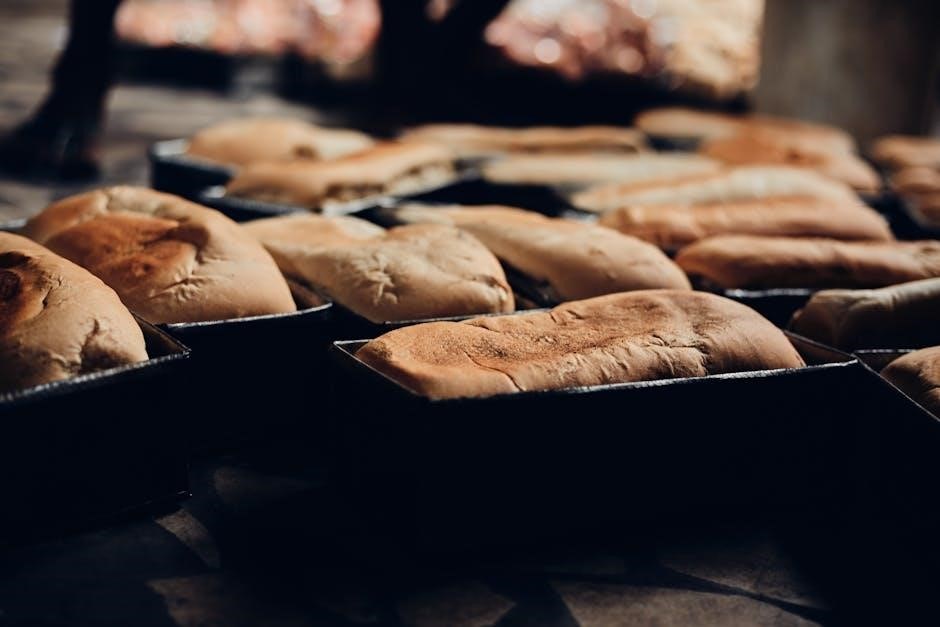Bread Givers, a novel by Anzia Yezierska, published in 1925 by Doubleday, Page & Company, explores the journey of Sara Smolinsky, a young Jewish immigrant woman, as she navigates the challenges of cultural identity, family traditions, and personal independence in 1920s New York. The book is widely regarded as a seminal work in American immigrant literature, offering a poignant portrayal of the struggles faced by Jewish women in the early 20th century. Its themes of self-discovery, gender roles, and cultural conflict continue to resonate with readers today, making it a timeless classic. The novel is also available in PDF format, ensuring its accessibility to modern audiences.
1.1 Publication Details and Significance
Bread Givers, written by Anzia Yezierska, was first published in 1925 by Doubleday, Page & Company. This novel is a landmark work in American immigrant literature, offering a vivid portrayal of Jewish immigrant life on Manhattans Lower East Side. The books significance lies in its exploration of cultural identity, gender roles, and the immigrant experience, resonating deeply with readers. A 2003 edition, published by Persea Books, includes a foreword by Alice Kessler-Harris, enhancing its historical and literary context. The novel is also available in PDF format, making it accessible to modern readers. With its enduring themes, Bread Givers remains a critical work in understanding the struggles and aspirations of early 20th-century Jewish immigrants in America.

Plot Summary
Bread Givers follows Sara Smolinsky, a young Jewish girl, as she navigates her journey from childhood to independence in 1920s New York. The novel explores her struggle against her father’s traditional beliefs, her sisters’ roles, and the family’s financial hardships, ultimately leading to her self-discovery and pursuit of a better life. Available in PDF, the story delves into themes of identity, family, and cultural adaptation, offering a vivid portrayal of immigrant life.
2.1 Setting: The Lower East Side of Manhattan in the 1920s
The novel is set in the vibrant yet challenging environment of Manhattan’s Lower East Side during the 1920s, a hub for Jewish immigrants. This bustling neighborhood, with its crowded streets, tenements, and lively markets, serves as the backdrop for Sara Smolinsky’s journey. The setting reflects the cultural and economic struggles of Jewish immigrants adapting to American life. The Lower East Side’s dynamic atmosphere, filled with traditions and modern influences, highlights the tension between old-world values and new-world opportunities; Available in PDF, the novel vividly portrays this setting, immersing readers in the sights, sounds, and struggles of early 20th-century immigrant life, shaping Sara’s quest for independence and identity.
2.2 Main Character: Sara Smolinsky’s Profile
Sara Smolinsky is the youngest daughter of a traditional Orthodox rabbi, Reb Smolinsky, and the protagonist of Bread Givers. Growing up in a impoverished Jewish immigrant household on the Lower East Side of Manhattan, Sara faces the oppressive expectations placed on her as a woman in a patriarchal culture. Determined and resilient, she rebels against her father’s rigid beliefs, seeking independence and self-discovery. Her journey reflects the broader struggles of Jewish immigrant women in the early 20th century, balancing cultural heritage with the pursuit of personal freedom. Available in PDF, the novel captures Sara’s transformation from a timid girl to a strong-willed individual, making her one of the most memorable characters in American immigrant literature.
2.3 Key Conflict: Sara vs. Reb Smolinsky
The central conflict in Bread Givers lies in the clash between Sara Smolinsky and her father, Reb Smolinsky, a traditional Orthodox rabbi. Reb represents the strict, patriarchal values of the Old World, insisting that women conform to roles of domesticity and submission. Sara, however, embodies the spirit of the New World, striving for independence, education, and self-determination. Their relationship is marked by tension, as Sara rebels against her father’s oppressive expectations, seeking to break free from the limitations imposed by her gender and cultural heritage. This conflict not only drives the plot but also symbolizes the broader struggle between tradition and modernity. Available in PDF, the novel vividly portrays this generational and cultural clash, highlighting Sara’s resilience and determination to forge her own path in life.

Themes
Bread Givers explores themes of women’s independence, cultural conflict, and the immigrant experience. Sara’s journey reflects the struggle for self-discovery and autonomy in a patriarchal society. Available in PDF, the novel highlights these enduring themes, resonating with contemporary readers.
3.1 Struggle for Women’s Independence
Bread Givers vividly portrays the struggle for women’s independence through Sara Smolinsky’s journey. In a patriarchal household, Sara rebels against her father’s rigid expectations, seeking education and a career. The novel highlights the societal constraints on women, particularly Jewish immigrants, who are expected to prioritize family over personal aspirations. Sara’s determination to break free from these norms reflects the broader fight for gender equality in the early 20th century. Her story, available in PDF, serves as a powerful testament to the resilience of women striving for autonomy in a male-dominated world. This theme remains deeply relevant today, resonating with readers who continue to navigate similar challenges.
3.2 Cultural Conflict: Old World vs. New World
Bread Givers explores the cultural clash between the traditional values of the Old World and the modern aspirations of the New World. Sara Smolinsky, the protagonist, embodies the New World’s ideals of independence and self-determination, while her father, Reb Smolinsky, clings to the rigid traditions of their Eastern European heritage. The novel vividly portrays the tension between these two perspectives, highlighting Sara’s struggle to reconcile her desire for education and career with her father’s insistence on maintaining religious and cultural norms. This conflict reflects the broader immigrant experience, where adapting to a new society often means navigating the gap between cherished traditions and evolving identities. The PDF version of the novel underscores this timeless theme, making it accessible to contemporary readers.
3.3 The Immigrant Experience
Bread Givers captures the essence of the immigrant experience through Sara Smolinsky’s journey, illustrating the challenges faced by Jewish immigrants in early 20th-century America. The novel portrays the struggles of adapting to a new culture, economic hardships, and the clash between traditional values and modern aspirations. Sara’s family, like many immigrants, faces poverty and the pressures of assimilation, while striving to maintain their cultural identity. The PDF version of the novel highlights these themes, offering readers a vivid glimpse into the lives of immigrants navigating a new world. This narrative serves as a powerful reminder of the resilience and determination required to build a life in a foreign land, resonating deeply with the experiences of many immigrants past and present.

Character Analysis
Bread Givers delves into the complexities of its characters, focusing on Sara Smolinsky’s pursuit of independence and her tense relationship with her traditional father, Reb Smolinsky. The novel also explores the roles of Sara’s sisters—Bessie, Mashah, and Fania—highlighting their individual struggles and contributions to the family dynamic, all while navigating the challenges of immigration and cultural adaptation.
4.1 Sara Smolinsky’s Journey
Sara Smolinsky’s journey in Bread Givers is a transformative exploration of self-discovery and defiance. As the youngest daughter of a traditional Orthodox rabbi, Sara challenges the restrictive gender roles imposed by her father and culture. From her early struggles in a patriarchal household to her eventual pursuit of education and independence, Sara’s path is marked by resilience and determination. Her journey reflects the broader experiences of immigrant women in the early 20th century, balancing cultural heritage with personal aspirations. Through her story, Yezierska illustrates the tension between tradition and modernity, as Sara navigates her identity as both a daughter of the Old World and a woman of the New.
4.2 Reb Smolinsky: The Traditional Patriarch
Reb Smolinsky, Sara’s father, is a rigid Orthodox rabbi clinging to traditional values in a rapidly changing world. His unwavering commitment to Jewish customs and patriarchal norms creates tension with Sara, who seeks independence. Reb Smolinsky believes women should focus on domestic duties and marry for financial security, not personal fulfillment. His strict adherence to tradition stems from his cultural upbringing, viewing modernity as a threat to his faith and authority. Throughout the novel, he represents the Old World, embodying the struggles of immigrants grappling with cultural preservation. His relationship with Sara highlights the clash between tradition and progress, making him a complex figure in the exploration of identity and heritage.
4.3 Bessie, Mashah, and Fania: Roles and Contributions
Bessie, Mashah, and Fania, Sara’s sisters, each embody distinct responses to the constraints of their traditional upbringing. Bessie, the eldest, is burdened with domestic responsibilities and financial support for the family, reflecting the societal expectations placed on women. Mashah, beautiful but vain, seeks escape through physical appearance and romantic fantasies, symbolizing the limited avenues for self-expression. Fania, the youngest, struggles with her own desires, caught between family obligations and personal aspirations. Together, they illustrate the varied ways women navigated the challenges of immigration and cultural identity, contributing to the novel’s exploration of gender roles and individual resilience in the face of societal norms and family expectations.

Historical Context
Bread Givers is set during the Progressive Era, highlighting the challenges of Jewish immigration to the U.S. in the early 20th century. The novel explores themes of poverty, cultural assimilation, and the struggle for women’s rights, reflecting the experiences of Jewish immigrants settling in New York City’s Lower East Side during this period.
5.1 Jewish Immigration to the U.S. in the Early 20th Century
The early 20th century witnessed a massive wave of Jewish immigration to the United States, primarily from Eastern Europe. Fleeing poverty, persecution, and political unrest, millions settled in urban areas like New York City’s Lower East Side. This period, known as the “Great Migration,” saw Jewish immigrants adapting to a new culture while preserving their traditions. Bread Givers captures this experience, highlighting the struggles of balancing Old World values with New World opportunities. The novel reflects the socio-economic challenges, cultural adjustments, and the quest for a better life that defined this era of Jewish immigration, providing a vivid portrayal of their resilience and determination to thrive in America.
5.2 The Lower East Side: A Hub for Jewish Immigrants
The Lower East Side of Manhattan in the early 20th century was a vibrant hub for Jewish immigrants, offering both challenges and opportunities. This bustling neighborhood, with its densely populated tenements and lively streets, became a melting pot of cultures. It was here that many Jewish families, like the Smolinskys in Bread Givers, struggled to adapt to American life while preserving their traditions. The area was known for its bustling markets, synagogues, and community organizations, which provided support to newcomers. Sara Smolinsky’s experiences in this dynamic environment highlight the tensions between old-world values and new-world aspirations, making the Lower East Side a pivotal setting for understanding the Jewish immigrant experience.

Author Background
Anzia Yezierska (1880?-1970) was a Jewish-American author known for her novels on immigrant life. Her most famous work, Bread Givers (1925), reflects her own experiences and explores themes of identity and cultural conflict.
6.1 Anzia Yezierska’s Background and Other Works
Anzia Yezierska, born around 1880 in Russian Poland, immigrated to the United States as a child. She grew up in New York City’s Lower East Side, where she experienced firsthand the struggles of Jewish immigrants. Yezierska began her writing career in the early 20th century, focusing on themes of immigration, identity, and gender. Her most famous novel, Bread Givers (1925), brought her acclaim for its raw, emotional portrayal of Jewish women’s lives. She also wrote short stories and essays, often drawing from her own life. Her other notable works include The Open Cage and All I Could Never Be. Yezierska’s writing continues to be celebrated for its authenticity and its exploration of cultural and personal identity.
6.2 Reception and Impact of “Bread Givers”
Bread Givers received critical acclaim upon its release in 1925 for its vivid portrayal of Jewish immigrant life and its exploration of gender roles. The novel was praised for its emotional depth and its ability to capture the struggles of first-generation Americans. It has since become a classic of American immigrant literature, influencing later works that explore themes of identity and cultural conflict. The book’s enduring popularity is evident in its availability in PDF format, making it accessible to modern readers. Its impact lies in its ability to resonate with diverse audiences, offering insights into the immigrant experience and the universal quest for self-discovery. Today, it remains a significant work in discussions of immigration, identity, and women’s independence.

Literary Style and Symbolism
Anzia Yezierska’s vivid prose in Bread Givers captures the gritty realism of immigrant life, while the symbolism of bread represents sustenance, sacrifice, and the family’s survival struggles.
7.1 Yezierska’s Prose Style
Anzia Yezierska’s prose in Bread Givers is characterized by its raw emotional intensity and vivid imagery, deeply rooted in her own immigrant experiences. Her writing often employs a lyrical yet straightforward style, which effectively conveys the harsh realities faced by Jewish immigrants in the early 20th century. Yezierska’s use of rich, evocative language immerses readers in the world of the Lower East Side, blending Yiddish idioms with English to create a unique narrative voice. This blend not only reflects the cultural duality of her characters but also enhances the authenticity of their struggles. Her prose is both poetic and unflinching, making Bread Givers a powerful exploration of identity, tradition, and resilience.
7.2 Symbolism of Bread
Bread in Bread Givers serves as a profound symbol, representing both sustenance and the weight of tradition. It embodies the physical and emotional nourishment Sara and her family strive for, reflecting their immigrant struggles. Bread also symbolizes the patriarchal expectations placed on women, as they are often seen as “bread givers,” responsible for sustaining their families. However, Sara’s rebellion against these roles signifies a rejection of the limitations imposed by such traditions. The novel uses bread to explore themes of cultural identity, family duty, and the tension between old-world values and new-world aspirations, making it a powerful metaphor for the immigrant experience and the quest for independence. This symbolism underscores the novel’s enduring relevance in discussions of identity and tradition.

PDF Version and Accessibility
The Bread Givers PDF version is widely available, offering readers convenient access to Anzia Yezierska’s classic novel. The digital format includes a foreword and introduction by Alice Kessler-Harris, enhancing its educational value. With clear formatting and readability, the PDF is ideal for students and scholars analyzing the text. It is accompanied by 16 black-and-white photographs, providing historical context. The novel is also downloadable in formats like TXT, making it accessible across devices. This accessibility ensures that Yezierska’s poignant portrayal of immigrant life remains relevant and easily attainable for modern audiences, fostering deeper engagement with its themes of identity and cultural conflict. The PDF version is a popular choice for academic and personal reading, ensuring the book’s legacy endures.
8.1 Availability and Format
The Bread Givers PDF is widely accessible online, available for download through platforms like Google Books, online archives, and educational websites. Published by Persea Books in its 3rd edition, the novel is offered in multiple digital formats, including PDF and TXT, ensuring compatibility with various devices. The PDF version retains the original narrative’s integrity, featuring a foreword by Alice Kessler-Harris and 16 black-and-white photographs that enhance its historical context. Readers can easily access the novel through free downloads or purchase options, making it a convenient resource for both academic and personal reading. Its digital availability has made Bread Givers a popular choice for students and scholars studying immigrant literature and cultural identity.
8.2 Popularity in Modern Times
Bread Givers remains a popular and relevant work in modern times, particularly in academic and literary circles. Its exploration of themes such as immigration, gender roles, and cultural identity continues to resonate with contemporary audiences. The availability of the Bread Givers PDF has further boosted its accessibility, making it a favorite among students and researchers. The novel’s enduring appeal lies in its vivid portrayal of the immigrant experience and its ability to spark discussions about identity and societal expectations. As a result, it is frequently included in university curricula and continues to be celebrated as a significant contribution to American literary heritage, ensuring its lasting impact and relevance in today’s society.

Educational Significance
Bread Givers is widely used in educational curricula for its rich exploration of immigration, gender, and cultural identity, making it a valuable resource for students and scholars alike.
9.1 Use in Curriculum
Bread Givers is frequently incorporated into high school and college curricula due to its exploration of themes such as immigration, gender roles, and cultural identity; The novel provides students with a vivid portrayal of the Jewish immigrant experience in the early 20th century, offering insights into the challenges faced by women in traditional households. Educators use the book to teach critical thinking and literary analysis, encouraging discussions on identity, family dynamics, and societal expectations. Additionally, the availability of the novel in PDF format makes it easily accessible for classroom use, ensuring that students can engage with the material without barriers. This accessibility has contributed to its enduring popularity in educational settings, where it serves as a powerful tool for understanding historical and cultural contexts.
9.2 Teaching Approaches and Contemporary Relevance
Teachers often use Bread Givers to explore themes of identity, immigration, and gender, fostering critical discussions about cultural heritage and social change. The novel’s vivid portrayal of Sara Smolinsky’s struggles resonates with students, encouraging empathy and reflection on historical and contemporary issues. Educators employ approaches like discussion groups, reflective writing, and comparative analysis with modern texts to highlight its relevance. The novel’s exploration of family dynamics and personal independence remains timely, helping students connect with universal themes of self-discovery and societal expectations. Its availability in PDF format supports interactive learning, allowing for easy annotation and digital engagement. This makes Bread Givers a valuable resource for fostering deeper understanding of immigrant experiences and cultural identity in today’s classrooms.

Legacy in American Literature
Bread Givers has influenced American literature by portraying immigrant and feminist experiences, shaping identity discussions, and inspiring later works. Its PDF availability ensures enduring relevance.
10.1 Influence on Later Works
Anzia Yezierska’s Bread Givers has profoundly influenced later literary works by offering a raw, unfiltered portrayal of immigrant life and gender dynamics. Its exploration of cultural identity and personal liberation inspired authors to delve into similar themes, particularly in feminist and immigrant narratives. The novel’s unflinching honesty and emotional depth have made it a benchmark for storytelling about the immigrant experience.
Moreover, its availability in PDF format has ensured its accessibility to modern readers and scholars, further cementing its impact on contemporary literature. The novel’s themes of self-discovery and cultural conflict continue to resonate, making it a foundational text for understanding the immigrant experience in America.
10.2 Contribution to Discussions on Immigration and Identity
Bread Givers significantly contributes to discussions on immigration and identity by vividly portraying the struggles of Jewish immigrants in early 20th-century America. Through Sara Smolinsky’s journey, the novel highlights the tensions between preserving cultural heritage and adapting to a new world. Yezierska’s work challenges stereotypes and offers a nuanced perspective on the immigrant experience, emphasizing the resilience and determination of women in particular. The novel’s exploration of identity formation resonates deeply, making it a crucial text for understanding the complexities of immigration and cultural assimilation. Its availability in PDF format ensures that these important themes remain accessible and relevant for modern readers and scholars alike.

